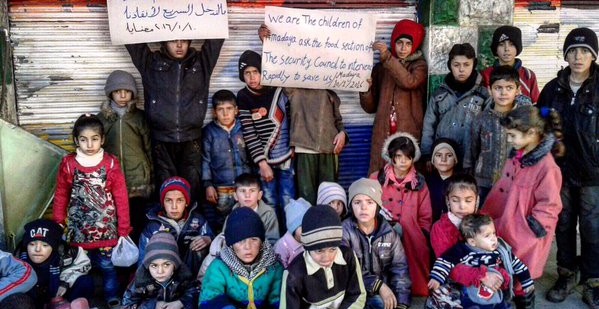PHOTO: Children appeal to international community during siege of Madaya in Damascus Province, January 2016
Kareem Chehayeb writes for Middle East Eye:
On 13 December 2016, Bashar Jaafari, the current permanent representative of Syria to the United Nations, declared: “Aleppo has been liberated from terrorists and those who toyed with terrorism; Aleppo has returned to the nation.”
After more than four years of fighting in Syria’s economic capital, the Syrian army, alongside pro-regime militias and Russia, had recaptured opposition-controlled eastern Aleppo.
Setting the skill of Hezbollah’s urban warfare and Russia’s juggernaut air force aside, it was the brutal siege of eastern Aleppo that laid the foundations for Assad’s major victory…after the Syrian army and other pro-regime forces cut off Castello Road, the last supply route for opposition forces and civilians living there.
By November, Medecins Sans Frontieres (MSF, Doctors Without Borders) reported that there were 32 doctors for 250,000 besieged residents, with shortages of basic medicines, such as painkillers.
And the rest is history.
Aleppo was not the first city to be besieged, nor will it be the last. On 23 December 2016, 12-year-old Mohamed al-Maleh in Madaya, besieged by the Syrian army and Hezbollah since June 2015, was severely injured when he was shot in the head by a sniper while playing on the roof.
Al-Maleh is one of 1.3 million people trapped in besieged communities across Syria, primarily by the Syrian army and its allies. This does not include more than 1.1 million others who are partially besieged or living in siege-like conditions, according to Siege Watch’s latest quarterly report on Syria.
Starve or Surrender
Prior to the Syrian government and its allies reclaiming eastern Aleppo, it has used similar tactics to win back opposition-held areas in and around other major cities in Syria, including the capital Damascus, as well as Homs, Syria’s third-largest city.
Near the capital Damascus is the large opposition stronghold in eastern Ghouta. Though the siege of the area lasted for three years from 2013 and 2016, in a territory significantly larger than eastern Aleppo both in size and population, its complicated situation, both in terms of internal politics among the opposition factions, and the relationship between those besieged and government-held areas, kept it from taking centre stage in the media.
Aron Lund’s analysis on eastern Ghouta for The Century Foundation indicates that several distinct features of this siege made it even more effective for the Syrian government and its allies.
First of all, internal clashes between factions, including Jaish al-Islam, led to the fragmentation of opposition groups in the area. Moreover, the black market has been a major source of income for officials on the side of the Syrian regime, as smugglers and traders went in and out of the besieged territory from time to time.
Outside of war strategy, this is an example of how the regime can benefit economically from sieges, as well as rhetorically; the Syrian government and Assad have been referring to the opposition as extremist Islamists and terrorists ever since day one, and the president has portrayed himself and his allies time and again as protectors of secularism and of ethnic and religious minorities in Syria.
Despite being proven to be such an effective tactic, it is always civilians who pay the price for such sieges.

